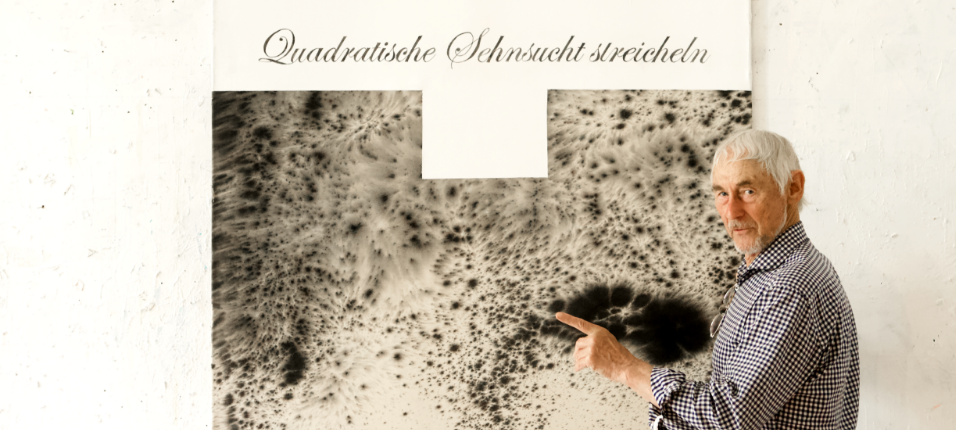"Caress this sign" – studio visit with Hans Peter Adamski

The Hackesche Höfe belong to the most popular sights in Berlin Mitte. The many visitors to the courtyards hardly notice what is going on in the more than 100 apartments on the upper floors. But most notice a work by artist Hans Peter Adamski. We visit him in his studio.
Hans Peter Adamski, born in 1947, has been working in his studio in courtyard 2 of the Hackesche Höfe for twelve years. He became a shooting star of the art market in the 1980s and taught at the Kunsthochschule Dresden. For the Bundestag, he decorated the Jakob Kaiser Building in Berlin with a mural that spans several stories. And state guests will in future be greeted by two large-format murals by Adamski in a reception building of the German government.
The rustle of the courtyards
Dressed in casual leisure wear, Adamski opens the door and you're already in the middle of the studio. Voices and sounds from the courtyard filter through the open window to the second floor. The hustle and bustle in the courtyards has become increasingly lively in the twelve years he has been a tenant there, he has noticed. Except for the two pandemic years. Adamski is happy about that. He spends a lot of time here alone with himself and his work. The background noise of the courtyards gives him the pleasant feeling of being among people – without them disturbing him. This, he says, is due to a special very relaxed atmosphere that prevails in the courtyards. "Nothing unpleasant ever happens here," Adamski says.

A sign in the courtyard
Another reason Adamski feels at home in the Hackesche Höfe: the proximity to one of his works. His sign "Bei aufkommenden Emotionen bitte hier streicheln" (In case of rising emotions please caress me) was purchased by the administration of the Höfe and mounted on a house wall below Adamski's studio. It is one of the most popular photo motifs of the courtyards. The artist loves to watch visitors react to his work or pose in front of it. Sometimes he joins them, reveals himself as its creator and asks for a photo in front of the sign. In the meantime, he has collected numerous photos. He would like to use a selection for a book project.

Social sculpture
He was particularly pleased recently about a friendly bride and groom who had their picture taken in front of his sign. This fits in with Adamski's intention to bring the emotional side of people into play in the form of signs in official language. Just a few days ago, a couple staged themselves in front of his sign in a completely different way. Amused, Adamski scrolls to the next photo: both are dressed in black fetish look and the man exposes a buttock of his partner. Thus the sign in courtyard 2 becomes a living example of a "social sculpture" which art guru Joseph Beuys, whose class Adamski attended as a student at the Düsseldorf Art Academy, was so fond of talking about.

Forbidden painting
At that time, in the 1970s, the art world was dominated by conceptual art: the idea was to be at the center of artistic creation. Art should not aim at a mere visual effect. Craftsmanlike virtuosity was frowned upon among artists. As a young artist, Adamski, too, wouldn’t touch a paintbrush under any circumstances. During a creative crisis, however, he decided together with artist friends to do the unthinkable: paint. In the artist and studio community "Mühlheimer Freiheit," they then painted without any inhibitions – an act of self-liberation. It did not have to be beautiful. Sometimes one painted into the work of someone else. The group was discovered by a renowned Cologne gallery owner and was soon part of the hype around young "wild" painting from Germany. The hype and commercialization soon became too much for Adamski. He withdrew from the art world into his studio for ten years and worked only for himself.

From Dresden to Berlin
In the mid-1990s, he became a professor at the Art Academy in Dresden. Even today, Adamski still raves about his studio there, with its eight-meter-high ceiling and view of the Elbe in a tower room of the art academy on Brühl's Terrace. When the decision to downsize to the Hackesche Höfe arose after the end of his tenure in Dresden, Adamski hesitated. As a renowned artist, one must also think of representation. But whether it was friends, gallery owners or the collection – as it turned out, everyone was delighted with his charming new location.

Images and texts
With pleasure Adamski presents a small selection of his works kept in the studio in front of the camera. He has always worked with many different means of expression. Looking at Adamski's more recent works, one has to notice that text elements play a major role. They are a component of many large-format paintings. But Adamski also continues to produce signs, staging and photographing them. Would he like more sign objects in the courtyards? Not very many, Adamski answers. But he could imagine one or two more of them.
